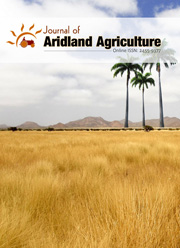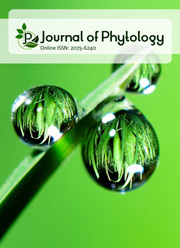Effect of wool pellets on soil fertility and lettuce growth in three soil types
DOI:
https://doi.org/10.25081/jaa.2025.v11.9572Keywords:
Agroecology, Lettuce, Organic fertilizer, Soil amendment, Wool pellets, WoolAbstract
Since 2010, South America has been experiencing a prolonged megadrought, with a 40% reduction in annual rainfall, further intensified by climate change. This situation has led to a severe decline in water reserves, impacting agriculture and food security. To mitigate these effects, the adoption of sustainable agricultural practices, such as the use of sheep wool as an organic fertilizer, has been explored. This study evaluated the impact of wool pellets on lettuce growth and soil properties across different substrates. Lettuce seedlings were cultivated in 1 L pots with various soil types (sand, clay, and peat) and different wool pellet doses: a control group (C), a group with 5 g/L (W5), and one with 10 g/L (W10). Plant growth parameters and soil properties were monitored over a period of 120 days. The addition of wool pellets improved soil moisture retention and chemical properties, with moisture levels increasing by 3% to 25% compared to the control, particularly during dry periods. An increase in nitrate (41-54%) and potassium (10-53%) concentrations was observed in both soil and lettuce leaves (1.4 times) compared to the control, particularly in sandy and clay soils. Lettuce growth was significantly enhanced under the W10 treatment, which showed the highest increases in plant weight (2.5 times), leaf number (1.4 times), and height (1.4 times) compared to the control. Wool pellets may thus serve as an effective tool for optimizing soil management in low-fertility environments, promoting more sustained and resilient plant growth under variable water availability.
Downloads
References
Abdallah, A. M., Ugolini, F., Baronti, S., Maienza, A., Ungaro, F., & Camilli, F. (2019a). Assessment of two sheep wool residues from textile industry as organic fertilizer in sunflower and maize cultivation. Journal of Soil Science and Plant Nutrition, 19, 793-807. https://doi.org/10.1007/s42729-019-00079-y
Abdallah, A., Ugolini, F., Baronti, S., Maienza, A., Camilli, F., Bonora, L., Martelli, F., Primicerio, J., & Ungaro, F. (2019b). The potential of recycling wool residues as an amendment for enhancing the physical and hydraulic properties of a sandy loam soil. International Journal of Recycling Organic Waste in Agriculture, 8, 131-143. https://doi.org/10.1007/s40093-019-0283-5
Araya-Osses, D., Casanueva, A., Román-Figueroa, C., Uribe, J. M., & Paneque, M. (2020). Climate change projections of temperature and precipitation in Chile based on statistical downscaling. Climate Dynamics, 54, 4309-4330. https://doi.org/10.1007/s00382-020-05231-4
Barrow, N. J., Debnath, A., & Sen, A. (2020). Measurement of the effects of pH on phosphate availability. Plant and Soil, 454, 217-224. https://doi.org/10.1007/s11104-020-04647-5
Blaes, X., Chomé, G., Lambert, M.-J., Traoré, P. S., Schut, A. G. T., & Defourny, P. (2016). Quantifying fertilizer application response variability with VHR satellite NDVI time series in a rainfed smallholder cropping system of Mali. Remote Sensing, 8(6), 531. https://doi.org/10.3390/rs8060531
Böhme, M., Pinker, I., Grüneberg, H., & Herfort, S. (2010). Sheep wool as fertiliser for vegetables and flowers in organic farming. Acta Horticulturae, 933, 195-202. https://doi.org/10.17660/ActaHortic.2012.933.23
Bradshaw, T., & Hagen, K. (2022). Wool pellets are a viable alternative to commercial fertilizer for organic vegetable production. Agronomy, 12(5), 1210. https://doi.org/10.3390/agronomy12051210
Cabrera, M. L., Kissel, D. E., & Vigil, M. F. (2005). Nitrogen mineralization from organic residues: Research opportunities. Journal of Environmental Quality, 34(1), 75-79. https://doi.org/10.2134/jeq2005.0075
Cassol, D., De Silva, F. S. P., Falqueto, A. R., & Bacarin, M. A. (2008). An evaluation of non-destructive methods to estimate total chlorophyll content. Photosynthetica, 46(4), 634-636. https://doi.org/10.1007/s11099-008-0109-6
Clivot, H., Mary, B., Valé, M., Cohan, J.-P., Champolivier, L., Piraux, F., Laurent, F., & Justes, E. (2017). Quantifying in situ and modeling net nitrogen mineralization from soil organic matter in arable cropping systems. Soil Biology and Biochemistry, 111, 44-59. https://doi.org/10.1016/j.soilbio.2017.03.010
Dal Prà, A., Ugolini, F., Negri, M., Bortolu, S., Duce, P., Macci, C., Lombardo, A., Benedetti, M., Brajon, G., Guazzini, L., Casini, S., Spagnul, S., & Camilli, F. (2024). Wool agro-waste biomass and spruce sawdust: Pellets as an organic soil amendment. Sustainability, 16(6), 2228. https://doi.org/10.3390/su16062228
De Neve, S. (2017). Organic matter mineralization as a source of nitrogen. F. Tei, S. Nicola & P. Benincasa (Eds.), Advances in Research on Fertilization Management of Vegetable Crops (pp. 65-83) Cham, Switzerland: Springer. https://doi.org/10.1007/978-3-319-53626-2_3
Dontsova, K. M., Norton, L. D., Johnston, C. T., & Bigham, J. M. (2004). Influence of exchangeable cations on water adsorption by soil clays. Soil Science Society of America Journal, 68(4), 1218-1227. https://doi.org/10.2136/sssaj2004.1218
Garreaud, R. D., Boisier, J. P., Rondanelli, R., Montecinos, A., Sepúlveda, H. H., & Veloso-Aguila, D. (2020). The central Chile mega drought (2010-2018): A climate dynamics perspective. International Journal of Climatology, 40(1), 421-439. https://doi.org/10.1002/joc.6219
Gee, G. W., & Bauder, J. W. (1986). Particle‐size analysis. In A. Klute (Ed.), Methods of soil analysis: Part 1 Physical and Mineralogical Methods (2nd ed., pp. 383-411) New York, UK: John Wiley & Sons, Inc. https://doi.org/10.2136/sssabookser5.1.2ed.c15
Haque, A. N. M. A., & Naebe M. (2022). Waste wool powder for promoting plant growth by moisture retention. Sustainability, 14(19), 12267. https://doi.org/10.3390/su141912267
Haydar, M. S., Ghosh, D., & Roy, S. (2024). Slow and controlled release nanofertilizers as an efficient tool for sustainable agriculture: Recent understanding and concerns. Plant Nano Biology, 7, 100058. https://doi.org/10.1016/j.plana.2024.100058
Huang, W. J., Yang, Q. Y., Peng, D. L., Huang, L. S., Zhang, D. Y., & Yang, G. J. (2014). Nitrogen vertical distribution by canopy reflectance spectrum in winter wheat. IOP Conference Series: Earth and Environmental Science, 17(1), 012051. https://doi.org/10.1088/1755-1315/17/1/012051
Hunter, M. C., Smith, R. G., Schipanski, M. E., Atwood, L. W., & Mortensen, D. A. (2017). Agriculture in 2050: Recalibrating targets for sustainable intensification. Bioscience, 67(4), 386-391. https://doi.org/10.1093/biosci/bix010
Kumar Sarangi, P., Subudhi, S., Bhatia, L., Saha, K., Mudgil, D., Prasad Shadangi, K., Srivastava, R. K., Pattnaik, B., & Arya, R. K. (2023). Utilization of agricultural waste biomass and recycling toward circular bioeconomy. Environmental Science and Pollution Research, 30, 8526-8539. https://doi.org/10.1007/s11356-022-20669-1
Leeds-Harrison, P. B., Shipway, C. J. P., Jarvis, N. J., & Youngs, E. G. (1986). The influence of soil macroporosity on water retention, transmission and drainage in a clay soil. Soil Use and Management, 2(2), 47-50. https://doi.org/10.1111/j.1475-2743.1986.tb00678.x
Marczak, D., Lejcuś, K., Kulczycki, G., & Misiewicz, J. (2022). Towards circular economy: Sustainable soil additives from natural waste fibres to improve water retention and soil fertility. Science of the Total Environment, 844, 157169. https://doi.org/10.1016/j.scitotenv.2022.157169
Masunga, R. H., Uzokwe, V. N., Mlay, P. D., Odeh, I., Singh, A., Buchan, D., & De Neve, S. (2016). Nitrogen mineralization dynamics of different valuable organic amendments commonly used in agriculture. Applied Soil Ecology, 101, 185-193. https://doi.org/10.1016/j.apsoil.2016.01.006
Murphy, B. W. (2015). Impact of soil organic matter on soil properties—a review with emphasis on Australian soils. Soil Research, 53(6), 605-635. https://doi.org/10.1071/SR14246
Neina, D. (2019). The role of soil pH in plant nutrition and soil remediation. Applied and Environmental Soil Science, 2019(1), 5794869. https://doi.org/10.1155/2019/5794869
ODEPA. (2014). Estudio: Mercado de la carne y lana ovina en Chile.
ODEPA. (2017). Encuesta ganado ovino.
Ordiales, E., Gutiérrez, J. I., Zajara, L., Gil, J., & Lanzke, M. (2016). Assessment of utilization of sheep wool pellets as organic fertilizer and soil amendment in processing tomato and broccoli. Modern Agricultural Science and Technology, 2(2), 20-35.
Penn, C. J., & Camberato, J. J. (2019). A critical review on soil chemical processes that control how soil pH affects phosphorus availability to plants. Agriculture, 9(6), 120. https://doi.org/10.3390/agriculture9060120
Rabot, E., Wiesmeier, M., Schlüter, S., & Vogel, H.-J. (2018). Soil structure as an indicator of soil functions: A review. Geoderma, 314, 122-137. https://doi.org/10.1016/j.geoderma.2017.11.009
Rawls, W. J., Pachepsky, Y. A., Ritchie, J. C., Sobecki, T. M., & Bloodworth, H. (2003). Effect of soil organic carbon on soil water retention. Geoderma, 116(1-2), 61-76. https://doi.org/10.1016/S0016-7061(03)00094-6
Rezanezhad, F., Price, J. S., Quinton, W. L., Lennartz, B., Milojevic, T., & Van Cappellen, P. (2016). Structure of peat soils and implications for water storage, flow and solute transport: A review update for geochemists. Chemical Geology, 429, 75-84. https://doi.org/10.1016/j.chemgeo.2016.03.010
Ritchie, H., Roser, M., & Rosado, P. (2022). Fertilizers. Our World in Data. Retrieved from https://ourworldindata.org/fertilizers
Sadzawka, R. A., Carrasco, R. M. A., Grez, Z. R., de la Luz Mora, G. M., Flores, P. H., & Reaman, A. (2006). Métodos de análisis recomendados para los suelos de Chile. Revisión 2006. Santiago, Chile: Serie Actas - Instituto de Investigaciones Agropecuarias, no. 34. Retrieved from https://hdl.handle.net/20.500.14001/8541
Sadzawka, R. A., Carrasco, R. M., Demanet, F. R., Flores, P. H., Grez, Z. R., Mora, G. M., & Neaman, A. (2007). Métodos de análisis de tejidos vegetales. Santiago, Chile: Serie Actas - Instituto de Investigaciones Agropecuarias, no. 40. Retrieved from https://hdl.handle.net/20.500.14001/8570
Sharma, S. C., Sahoo, A., & Chand, R. (2019). Potential use of waste wool in agriculture: An overview. Indian Journal of Small Ruminants, 25(1), 1-12. https://doi.org/10.5958/0973-9718.2019.00019.9
Song, X., Chen, C., Arthur, E., Tuller, M., Zhou, H., Shang, J., & Ren, T. (2022). Cation exchange capacity and soil pore system play key roles in water vapour sorption. Geoderma, 424, 116017. https://doi.org/10.1016/j.geoderma.2022.116017
Spadoni, G. L., Cavalli, A., Congedo, L., & Munafò, M. (2020). Analysis of Normalized Difference Vegetation Index (NDVI) multi-temporal series for the production of forest cartography. Remote Sensing Applications: Society and Environment, 20, 100419. https://doi.org/10.1016/j.rsase.2020.100419
Vončina, A., & Mihelič, R. (2013). Sheep wool and leather waste as fertilizers in organic production of asparagus (Asparagus officinalis L.). Acta Agriculturae Slovenica, 101(2), 191-200. https://doi.org/10.14720/aas.2013.101.2.14910
Wen, G., Rippon, J. A., Brady, P. R., Wang, X. G., Liu, X., & Cookson, P. G. (2009). The characterization and chemical reactivity of powdered wool. Powder Technology, 193(2), 200-207. https://doi.org/10.1016/j.powtec.2009.03.021
Yudina, L., Sukhova, E., Gromova, E., Mudrilov, M., Zolin, Y., Popova, A., Nerush, V., Pecherina, A., Grishin, A. A., Dorokhov, A. A., & Sukhov, V. (2023). Effect of duration of LED lighting on growth, photosynthesis and respiration in lettuce. Plants, 12(3), 442. https://doi.org/10.3390/plants12030442
Published
How to Cite
Issue
Section
Copyright (c) 2025 Lina Maria Correa, Giordano Catenacci Aguilera, Marcela Gómez Ceruti

This work is licensed under a Creative Commons Attribution-NonCommercial 3.0 Unported License.





 .
.